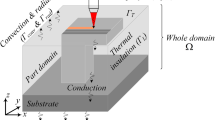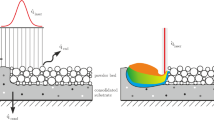Abstract
Physics-based thermal simulation of laser powder bed fusion can greatly help understanding the process and reducing time and cost associated with experimental approaches. Numerical methods including the finite element method have been widely used to predict parts thermal-structural history during the build process. However, the simulation has scalability issues because both layer thickness and laser spot diameter are too tiny compared to the part-scale. Therefore, it is only feasible to run these simulations with massive computational resources or if the boundary conditions are simplified, which inevitably reduces the prediction accuracy. This paper proposes a tetrahedral element-based scan-wise adaptive remeshing framework for thermal simulation of the selective laser melting (SLM) process. Results show that a significant reduction of the computational time and resources can be achieved due to the reduction of the number of nodes. The proposed framework enables part-scale thermal modeling of the SLM process with detailed thermal history without sacrificing the accuracy. The effectiveness of the proposed framework is demonstrated through a large size cantilever problem.


















Similar content being viewed by others
References
Thijs L, Verhaeghe F, Craeghs T, Van Humbeeck J, Kruth J-P (2010) A study of the microstructural evolution during selective laser melting of Ti–6Al–4V. Acta Mater 58(9):3303–3312
Zhang S, Wei Q, Cheng L, Li S, Shi Y (2014) Effects of scan line spacing on pore characteristics and mechanical properties of porous Ti6Al4V implants fabricated by selective laser melting. Mater Des 63:185–193
Gong H, Rafi K, Gu H, Starr T, Stucker B (2014) Analysis of defect generation in Ti–6Al–4V parts made using powder bed fusion additive manufacturing processes. Addit Manuf 1–4:87–98
Dilip JJS et al (2017) Influence of processing parameters on the evolution of melt pool, porosity, and microstructures in Ti-6Al-4V alloy parts fabricated by selective laser melting. Prog Addit Manuf 2(3):157–167
Gong H, Rafi K, Gu H, Janaki Ram GD, Starr T, Stucker B (2015) Influence of defects on mechanical properties of Ti–6Al–4V components produced by selective laser melting and electron beam melting. Mater Des 86:545–554
Leuders S et al (2013) On the mechanical behaviour of titanium alloy TiAl6V4 manufactured by selective laser melting: fatigue resistance and crack growth performance. Int J Fatigue 48:300–307
Zhao X et al (2016) Comparison of the microstructures and mechanical properties of Ti–6Al–4V fabricated by selective laser melting and electron beam melting. Mater Des 95:21–31
Ali H, Ghadbeigi H, Mumtaz K (2018) Effect of scanning strategies on residual stress and mechanical properties of selective laser melted Ti6Al4V. Mater Sci Eng A 712:175–187
Khairallah SA, Anderson AT, Rubenchik A, King WE (2016) Laser powder-bed fusion additive manufacturing: physics of complex melt flow and formation mechanisms of pores, spatter, and denudation zones. Acta Mater 108:36–45
Khairallah SA, Anderson A (2014) Mesoscopic simulation model of selective laser melting of stainless steel powder. J Mater Process Technol 214(11):2627–2636
Mindt HW, Desmaison O, Megahed M, Peralta A, Neumann J (2018) Modeling of powder bed manufacturing defects. J Mater Eng Perform 27(1):32–43
Andreotta R, Ladani L, Brindley W (2017) Finite element simulation of laser additive melting and solidification of Inconel 718 with experimentally tested thermal properties. Finite Elem Anal Des 135:36–43
Michaleris P (2014) Modeling metal deposition in heat transfer analyses of additive manufacturing processes. Finite Elem Anal Des 86:51–60
Pal D, Patil N, Kutty KH, Zeng K, Moreland A, Hicks A, Beeler D, Stucker B (2016) A generalized feed-forward dynamic adaptive mesh refinement and derefinement finite-element framework for metal laser sintering—part II: nonlinear thermal simulations and validations 2. J Manuf Sci Eng 138(6):061003. https://doi.org/10.1115/1.4032078
Hussein A, Hao L, Yan C, Everson R (2013) Finite element simulation of the temperature and stress fields in single layers built without-support in selective laser melting. Mater Des 52:638–647
Roy S, Juha M, Shephard MS, Maniatty AM (2018) Heat transfer model and finite element formulation for simulation of selective laser melting. Comput Mech 62(3):273–284. https://doi.org/10.1007/s00466-017-1496-y
Karayagiz K, Elwany A, Tapia G, Franco B, Johnson L, Ma J, Karaman L, Arróyave R (2018) Numerical and experimental analysis of heat distribution in the laser powder bed fusion of Ti-6Al-4V. IISE Trans 9:1–17
Mishra AK, Kumar A (2019) Numerical and experimental analysis of the effect of volumetric energy absorption in powder layer on thermal-fluidic transport in selective laser melting of Ti6Al4V. Opt Laser Technol 111:227–239
Patil N, Pal D, Rafi HK, Zeng K, Moreland A, Hicks A, Beeler D, Stucker B (2015) A generalized feed forward dynamic adaptive mesh refinement and derefinement finite element framework for metal laser sintering—part I: formulation and algorithm development. J Manuf Sci Eng 137(4):041001
Ning J, Sievers DE, Garmestani H, Liang SY (2019) Analytical modeling of transient temperature in powder feed metal additive manufacturing during heating and cooling stages. Appl Phys A Mater Sci Process 125(8):1–11
Luo Z, Zhao Y (2019) Numerical simulation of part-level temperature fields during selective laser melting of stainless steel 316L. Int J Adv Manuf Technol 104(5–8):1615–1635
Gouge M, Denlinger E, Irwin J, Li C, Michaleris P (2019) Experimental validation of thermo-mechanical part-scale modeling for laser powder bed fusion processes. Addit Manuf 29:100771
Olleak A and Xi Z 2018 “Finite element modeling of the selective laser melting process for Ti-6Al-4V,” in Solid Freeform Fabrication 2018: Proceedings of the 29th Annual International, pp. 1710–1720
Olleak A, Xi Z (2019) Simulation of layer-by-layer selective laser melting process with an efficient remeshing technique. Procedia Manuf 34:613–618
Gong H et al (2014) Melt pool characterization for selective laser melting of Ti-6Al-4V pre-alloyed powder. Solid Free Fabr Symp Proc:256–267
D. L. Logan, A First Course in the Finite Element Method, 5th. Cangage, 2011
Luo Z, Zhao Y (2018) A survey of finite element analysis of temperature and thermal stress fields in powder bed fusion additive manufacturing. Addit Manuf 21, no. March 2017:318–332
Bergman D, Theodore L, Lavine AS, Incropera FP, DeWitt P (2019) Fundamentals of Heat and Mass Transfer, 8th edn. Wiley
Funding
Authors appreciate research funding support from DARPA (Young Faculty Award) and ANSYS for providing the software and technical support.
Author information
Authors and Affiliations
Corresponding author
Additional information
Publisher’s note
Springer Nature remains neutral with regard to jurisdictional claims in published maps and institutional affiliations.
Rights and permissions
About this article
Cite this article
Olleak, A., Xi, Z. A scan-wise adaptive remeshing framework for thermal simulation of the selective laser melting process. Int J Adv Manuf Technol 107, 573–584 (2020). https://doi.org/10.1007/s00170-020-04995-7
Received:
Accepted:
Published:
Issue Date:
DOI: https://doi.org/10.1007/s00170-020-04995-7




